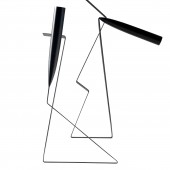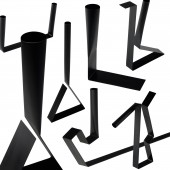DESIGN NAME:
Opposites In Unity
PRIMARY FUNCTION:
Candleholder and Vases
INSPIRATION:
Shanghai is a vast construction site in progress. In the western part of the city there is a materials market, where the designer often goes to collect some leftovers. It is with these unwanted objects that he started this series called Opposites In Unity. His original goal is to simply show the beauty of the materials themselves. With the joy of a child, the designer flattened a part of the metal pipe, he kept the actual machining of the Opposites in Unity series at a low level, mostly consisted of flattening and folding, just like little kids playing with twigs. Simple modeling brings rich philosophical thinking and artistic matching effect.
UNIQUE PROPERTIES / PROJECT DESCRIPTION:
The designer realized that the alteration of the metal pipe had brought about a visual language that speaks conflict and reciprocal causation, which shapes both a three-dimensional object and a two-dimensional surface. Visually, the line, the surface, and the object appear as pure forms in their spatial relationships, creating, altering, and contrasting with one another. At the same time, their conflict and reciprocal causation generate a dramatic effect with philosophical connotations. He kept the actual machining of the Opposites In Unity series at a low level, mostly consisted of flattening and folding, just like little kids playing with twigs.
Overall, as a designer, find his joy in viewing the world from the aesthetic point of view and offer opportunities for cultural reflection and association. In other words, through the Opposites In Unity series, by exploring the theme of conflict and harmony, he present his understanding and appreciation of art and forms.
OPERATION / FLOW / INTERACTION:
Opposites In Unity reminds the people how conflicting values and ideologies—East and West, reality and mind, religion and science, realism and idealism, etc.—complete each other to make a balanced whole.
This initial understanding of the designer runs through the subsequent development of his series. For example, No. 1 and No. 2 continue to use the series’ basic forms to expand on the theme of conflict and harmony, but they do so with respective variations. The bases in No. 3 and No. 4 are triangle-shaped to convey elegance and solemnity, which, combined with the columns in the pieces, create dramatic effects. No. 5 has a surrealistic flavor whereas No. 6 and No. 7 seek progressive decorativeness.
Still, as a product designer, he played with the idea of commercializing the Opposites In Unity series. He came up with a table-art-sculptures, and even a desk-mate that is also a small bookshelf, featuring a geometric frame in which one can keep a few books, to be reached readily from one’s bed. Every item is simple in shape to go with the modern sense of beauty; its main body and the base are integrated into one piece; still, it is stable and nicely functional. Used as a decorative piece in a room, it adds visual energy, even flower arrangement looks more artistic. The inspiration for this particular design comes from Opposites In Unity.
PROJECT DURATION AND LOCATION:
About Siince2020
In 2017 Siince2020 was born in Shanghai, China.
As their name suggest: they believe in the "near future"- A tangible future they can all touch. This is where Shanghainese pragmatism and design meets.
Opposites In unity is an unreleased series, has started in 2016.
FITS BEST INTO CATEGORY:
Furniture Design
|
PRODUCTION / REALIZATION TECHNOLOGY:
In the western part of the Shanghai city there is a materials market, where the designer often go to collect some leftovers. It is with these unwanted objects that he started his series called Opposites In Unity.
The designer flattened a part of the pipe so as to better define the spaces. He kept the actual machining of the Opposites in Unity series at a low level, mostly consisted of flattening and folding, just like little kids playing with twigs.
SPECIFICATIONS / TECHNICAL PROPERTIES:
size:H80mm—600mm; L80mm—700mm
QTY:7
TAGS:
metal vase, candlestick, home decoration, decoration conceptual design
RESEARCH ABSTRACT:
With the joy of a child, the designer looked through a metal pipe as if it was a single-tube telescope. This act led him to the discovery of two spaces, one over here, the other out there. He flattened a part of the pipe so as to better define the spaces. Without himself knowing it, he had started this series called Opposites In Unity. The designer realized that the alteration of the pipe had brought about a visual language that speaks conflict and reciprocal causation, which shapes both a three-dimensional object and a two-dimensional surface.
Opposites In Unity reminds the people how conflicting values and ideologies—East and West, reality and mind, religion and science, realism and idealism, etc.—complete each other to make a balanced whole. This idea is at the core of traditional Chinese philosophy, an idea that ancient Chinese termed zhongyong—the Doctrine of the Mean.
It is the designer's hope that Opposites In Unity will inspire the pursuit of higher meanings in formal beauty, namely the substance – the messages conveyed through a visual language.
CHALLENGE:
It is designer's hope that Opposites In unity will inspire the pursuit of higher meanings in formal beauty, namely the substance – the messages conveyed through a visual language. Also important is a mindset that shows moderation and respect, especially when choosing materials and deciding on mechanical processing, which will make industrial production easier. He is no fan of devices that are just displays or composites of visual symbols, and he oppose designing for the sake of designing. A designed item should be a vessel of culture, the idea for which should come from life, not merely books or magazines. Since people in real life are vessels of culture themselves. When they purchase devices accordingly conceived, they will experience and appreciate the beauty in the world.
ADDED DATE:
2019-01-19 11:41:53
TEAM MEMBERS (1) :
Firo Wang, Co-Founder of Siince2020 design team, chief designer
IMAGE CREDITS:
Image #1: Co-Founder of siince2020 design team, chief designer, Firo Wang, 2017
Image #2: Co-Founder of siince2020 design team, chief designer, Firo Wang, 2017
Image #3: Co-Founder of siince2020 design team, chief designer, Firo Wang, 2017
Image #4: Co-Founder of siince2020 design team, chief designer, Firo Wang, 2017
Image #5:Co-Founder of siince2020 design team, chief designer, Firo Wang, 2017
PATENTS/COPYRIGHTS:
Siince2020 design team, 2018
|










